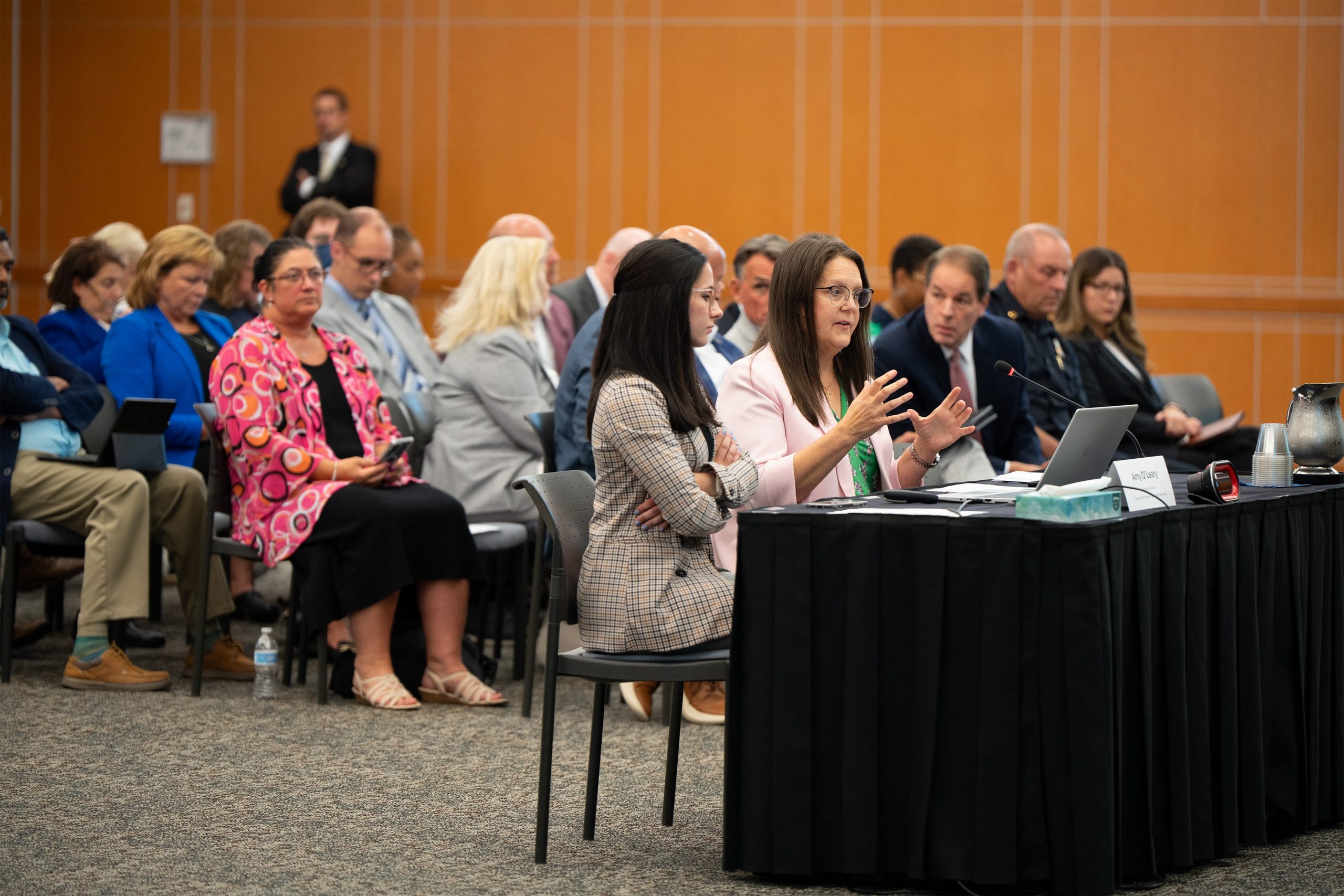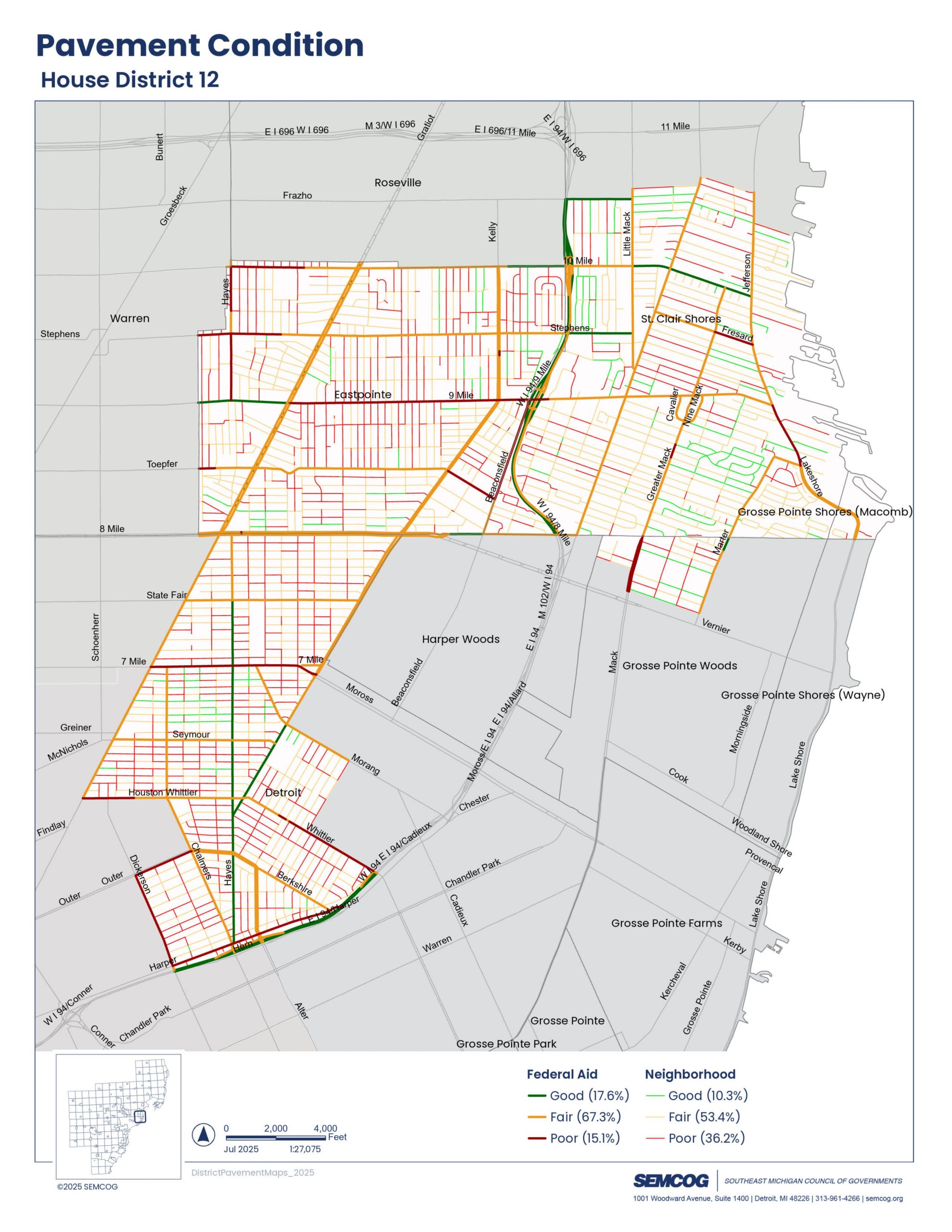Last month, SEMCOG Executive Director Amy O’Leary testified that Southeast Michigan’s roads are severely underfunded to the Michigan House’s State and Local Transportation Appropriations Subcommittee. O’Leary quantified the scale of the issue for federal aid roads, non-federal aid or “neighborhood” roads, and local bridges.
Local federal aid roads include highways, arterials, and major collectors. They can be owned either by county road commissions or cities/villages. Despite being eligible for federal transportation funding, nearly 32% of Southeast Michigan’s federal-aid roads owned by county road commissions or cities/villages are in poor condition. To bring 80% of these locally owned roads to good or fair condition by 2034, SEMCOG estimates an additional $550 million per year is needed.
Neighborhood roads, or roads not eligible for federal aid, are in even worse shape. SEMCOG and other metropolitan planning organizations do not receive funding to rate these lower-volume roads. Nonetheless, SEMCOG and local agencies work to gather as much condition data as possible. SEMCOG’s current dataset shows that approximately 49% of neighborhood roads are in poor condition. To bring Southeast Michigan’s neighborhood streets to 80% good or fair condition by 2034, SEMCOG estimates at least $440 million in annual funding is required.
Locally owned bridges have very limited funding options to make the necessary repairs. Each year, the federal government provides about $25 million in aid for local bridges, while Michigan contributes approximately $27 million through the Local Bridge Fund. The Local Bridge Fund is supported by a flat tax on gasoline sales, which has caused revenue to remain relatively stagnant for the past two decades. In 2021, an additional $196 million was made available through the federal Coronavirus Response and Relief Supplemental Appropriations Act (CRRSAA). However with CRRSAA funds now nearly exhausted, Michigan bridges face a looming funding cliff, even as infrastructure needs continue to grow.
Case in point: For the Fiscal Year 2027 construction cycle, the Michigan Department of Transportation received 400 applications for bridge funding, requesting a total of $515 million. However, even with the one-time CRRSAA funding boost and the regular Local Bridge Fund, only $80 million was available to award. Currently, about 978 of Michigan’s 6,756 locally owned bridges—roughly 14%—are in poor or severe condition. This statewide ratio closely mirrors that of Southeast Michigan, where 17% of locally owned bridges are in poor condition.

Driven by Millages: Communities Invest in Better Roads
In addition to condition data, O’Leary highlighted that local governments are stepping up to address the funding gap. In 2024, 78 local governments across Southeast Michigan, along with Washtenaw and St. Clair counties, had active road millages generating a combined $143 million in local transportation funding. That number is expected to grow, with projections nearing $150 million in 2025. Notably, eight communities have adopted two separate millages just to meet their transportation infrastructure needs—underscoring both the demand and the willingness of residents to invest in better roads. Townships hold nearly half of all municipal millages in the Southeast Michigan region. Mostly, township road millages are used for maintenance of the road network, like in Bloomfield Township. According to Michael Schostak, Bloomfield Township Treasurer, the community uses the funding to clean streets, plow snow, and patch potholes. However, a dedicated millage is only one way that Bloomfield Township residents are investing in their roads.
Like all other townships in Michigan, Bloomfield does not own their roads but instead relies on the Road Commission for Oakland County (RCOC) to undertake major repairs and replacements. Given that the road commission receives limited funding and must prioritize major roadways, neighborhood roads are often deprioritized, leading to poor conditions. In Bloomfield Township, neighborhoods have the option of adding a special assessment on themselves to pay for the construction, however these currently run as high as $55,000 over 15 years according to Treasurer Schostak. While the township has instituted a Special Assessment Deferment Program, the direct financial burden on residents is still significant.
Washtenaw County renewed and restored its four-year County-Wide Roads and Non-Motorized Millage in August of 2024, with construction set for 2025-2028. Brent M. Schlack, P.E., County Highway Engineer & Director of Engineering, stated that these millage dollars have “helped provide a steady stream of funds to help with our primary roadway system.”
The Washtenaw County Road Commission actively uses asset management strategies, guided by Pavement Surface Evaluation and Rating (PASER) data, to prioritize projects and extend the service life of its primary roads—making the limited dollars stretch further. However, even with this strategic approach, Director Schlack noted that, “additional funds would be helpful to improve our poor roads, culverts, and bridges. Our local roadway system is also in great need of additional funds.”
Both of these millages, along Bloomfield Township’s special assessment program, show that despite a community’s best efforts— and strong public support for local infrastructure projects—there simply isn’t enough funding in the pot for locals to adequately maintain their neighborhood roads.
All Roads Lead to Lansing
The Michigan House of Representatives passed their roads package along with a budget earlier this week, which proposed increasing statewide investment in transportation infrastructure by roughly $3 billion (more information on the House budget will be provided in a legislative update mailing next week, so be sure to subscribe). The Governor’s plan released earlier this year also targeted a $3 billion mark. To implement a solution at this scale, both chambers of the Legislature and the Governor will need to rally around a concrete plan.
SEMCOG is working to elevate the voices of locals in conversations with both legislative chambers, emphasizing that aging infrastructure, property tax limitations, and a declining population have collectively created a growing funding crisis. While we are proud to carry this message, our local government partners bring valuable, community-specific anecdotes that make the case even more compelling. We encourage you to reach out to your legislators and ask for increased investment in the locally owned transportation network. Share resident feedback and your experiences related to road conditions. Urge the legislature not to fall into the pothole of thinking that now is not the appropriate time to act.

If you would like community-specific pavement data to back up your account, you can download it directly from our website. Please don’t hesitate to reach out to SEMCOG if you have any trouble with this if you have any trouble with this. In the past few weeks, we have been printing and hand-delivering our in Southeast Michigan to help state leaders understand the scale of these infrastructure issues. Initial feedback from these offices suggests that they appreciate having reliable, district-specific data to use in budget conversations custom road condition maps for every legislative district in Southeast Michigan to help state leaders understand the scale of these infrastructure issues. Initial feedback from these offices suggests that they appreciate having reliable, district-specific data to use in budget conversations.
Continued underinvestment means roads deteriorate past the point of preventative maintenance—leading to full reconstruction costs that are far higher than preventative maintenance. This is why despite the fiscal impact of federal policy changes at the state level, now is the time to act.
Let’s make sure our infrastructure gets the investment it needs, before the costs grow even greater.

Leave a Reply